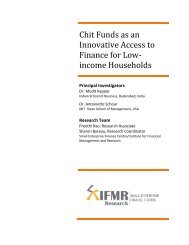Government of India Volume I: Analysis and Recommendations
Government of India Volume I: Analysis and Recommendations
Government of India Volume I: Analysis and Recommendations
You also want an ePaper? Increase the reach of your titles
YUMPU automatically turns print PDFs into web optimized ePapers that Google loves.
Table <strong>of</strong> <strong>Recommendations</strong> 9.1 Objectives<br />
SYSTEMIC RISK<br />
The Commission notes that even if individual institutions appear sound <strong>and</strong> are well-monitored, system-wide risks<br />
may build up in the aggregate. Such risks need to be monitored, identified <strong>and</strong> addressed - with a system-wide<br />
perspective <strong>and</strong> not a sectoral perspective. Hence there is a need for an agency to:<br />
1. Foster the stability <strong>and</strong> resilience <strong>of</strong> the financial system by identifying, monitoring <strong>and</strong> mitigating systemic<br />
risk; <strong>and</strong><br />
2. Improve co-ordination between multiple regulatory agencies (such as the micro-prudential regulators, the<br />
resolution corporation <strong>and</strong> other agencies within the financial system) by bringing diverse perspectives into<br />
the discussion, engaging with the regulatory stake-holders, identifying <strong>and</strong> reducing regulatory uncertainty<br />
(including regulatory arbitrage), <strong>and</strong> addressing unregulated areas.When a systemic crisis materialises, the<br />
agency must assist the Ministry <strong>of</strong> Finance <strong>and</strong> regulatory agencies in their efforts relating to resolving the<br />
crisis.<br />
Many <strong>of</strong> the crises <strong>of</strong> the past, <strong>and</strong> hypothetical crisis scenarios <strong>of</strong> the future, are indictments<br />
<strong>of</strong> the limits <strong>of</strong> such regulation, st<strong>and</strong>ing alone. Increasing institutional capacity to<br />
address the problems <strong>of</strong> consumer protection, micro-prudential regulation <strong>and</strong> resolution<br />
will certainly work to diminish systemic risk, however, such risk will not be eliminated.<br />
The Commission notes that despite well-intentioned implementation, flaws in institutional<br />
design, <strong>and</strong> errors <strong>of</strong> operation in existing institutional arrangements are inevitable.<br />
Additionally, even if extant consumer protection, micro-prudential regulation<br />
<strong>and</strong> resolution regimes work perfectly, some systemic crises may not be prevented, <strong>and</strong><br />
measures to contain such crises will need to be developed. These dimensions <strong>of</strong> concern<br />
call for urgent <strong>and</strong> thorough work in the field <strong>of</strong> systemic risk oversight, as a fourth pillar<br />
<strong>of</strong> financial regulation.<br />
9.2. Objectives <strong>and</strong> principles<br />
While there is a clear case for establishing institutional capacity in these areas, it is also<br />
important to be specific in the enunciation <strong>of</strong> its implementation. Unless systemic risk<br />
regulation is envisioned as a precise set <strong>of</strong> functions, demarcated by clear <strong>and</strong> concrete<br />
rules as specified by the draft Code, systemic risk law could easily devolve into a set <strong>of</strong><br />
vaguely specified sweeping powers, <strong>and</strong> there could be a danger <strong>of</strong> sacrificing the goals<br />
<strong>of</strong> development <strong>and</strong> efficiency in favour <strong>of</strong> avoiding potential systemic risk. Therefore,<br />
the Commission has taken care to precisely articulate the strategy for systemic risk oversight,<br />
seeking to avoid any draconian control <strong>of</strong> regulatory powers <strong>and</strong> emphasising on<br />
inter-regulatory agency co-ordination. The Commission’s recommendations also emphasise<br />
broad principles <strong>of</strong> regulatory governance so as to ensure that the operations<br />
<strong>of</strong> an agency charged with such functions are guided by an appropriate set <strong>of</strong> checks <strong>and</strong><br />
balances.<br />
Table 9.1 enunciates the objectives <strong>of</strong> systemic risk oversight.<br />
Table 9.2 lists the principles that should guide the functioning <strong>of</strong> the agency designated<br />
to monitor <strong>and</strong> address systemic risk concerns.<br />
9.3. Institutional arrangement<br />
The monitoring <strong>of</strong> systemic risk across the world, in varying capacities, has resulted in<br />
countries adopting differing structural frameworks for this purpose. For example, the UK<br />
has envisaged a Financial Policy Committee, located within the Bank <strong>of</strong> Engl<strong>and</strong>, that<br />
functions in a manner analogous to its Monetary Policy Committee. The US has established<br />
a statutory body called the Financial Stability Oversight Council which comprises<br />
the heads <strong>of</strong> various regulatory agencies <strong>and</strong> government representatives. Similarly, the<br />
90 FINANCIAL SECTOR LEGISLATIVE REFORMS COMMISSION



